
Enjoy forest bathing but don’t know your mountain ash from your downy birch? Never fear – fellow botanical ignoramus David Lintern has a beginner’s guide.
Over the summer, we went camping with the kids on the moors, pitching up for a couple of days near a small burn. After a brief but rigorous interrogation that any parent will recognise, I realised I had no clue what the slightly scrappy looking trees that lined the banks were. It’s embarrassing to admit, but no surprise really – I grew up surrounded by bricks and concrete, far from where I stay now, and pretty cut off from the natural world. I’m keen that my kids grow up knowing a little more than I do.
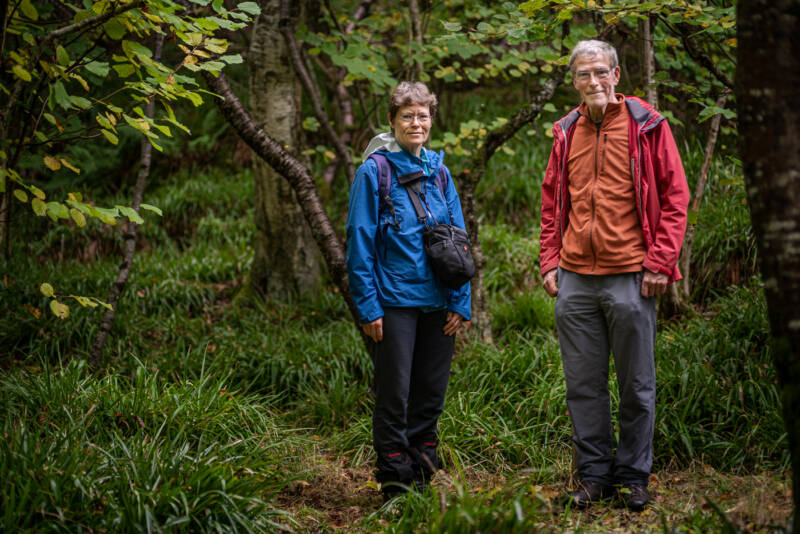
I messaged a couple of people who do know about these things, and a few months later, found myself walking up the banks of a different burn with our guides for the day. Outdoor writer Felicity and forester Andrew are very involved in woodland regeneration – both at the Comrie Community Woodland and on their own small patch elsewhere – and I hope to revisit them there, another time. In the meantime, they’ve been kind enough to share their decades of combined experience with us, here.
I learnt that there are around 20 tree species native to Scotland. We haven’t included everything here, but it does mean we stand half a chance of getting to know them, over time. For me, doing a tree ID walk locally has been perfect, because it’s repeatable. I just try to recall a little more, each time I’m out.
I also learnt that trees are weird, their truths at least as strange as fiction. They can be multigender, form complex relationships with bugs and even have ‘mouths’. It’s also fascinating to learn more about how our ancestors worked with them – not always in conflict, but often in collaboration.
Let’s start with the species that flummoxed me at the start.
Alder

Alder likes the damp and lines many of our small burns and rivers. The leaves are oval, medium sized and the trunks of old trees are often quite twisted. It was often managed through a process called coppicing (cutting young tree stems near the ground every so often, to encourage new growth) for firewood and fine grade charcoal, which because of its quality was often the first choice for gunpowder when mixed with saltpetre. The timber is very water resistant so was also used in pier structures and crannog ‘stilts’, as well as making clogs.
In an amazing (and quite weird) act of plant-animal symbiosis, the alder provides a home for gall wasps (not pictured), who lay their eggs on young leaves. The tree then grows a protective gall around the larvae to shield itself from being eaten. The wasps provide food for many birds, including siskins, early warblers and blue tits. The ones that make it until autumn, fall with the leaf to the ground and pupate in the leaf litter, before repeating the process in the spring. There are hundreds of species of gall wasps, each adapted to individual tree species.
Wych Elm
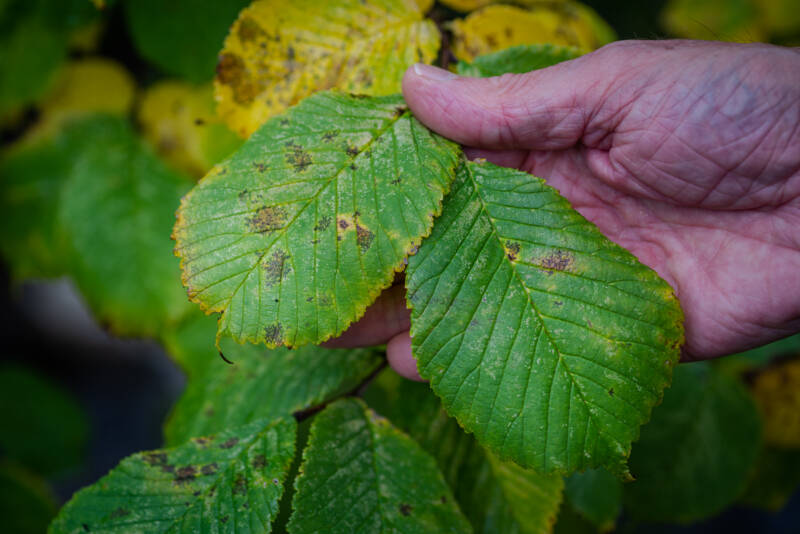
The native elm to Scotland has a broad, rough textured leaf with serrated edges. It grows well in hedges and likes riverbanks too. It’s quite a resilient tree – it’ll survive coppicing and if affected by Dutch elm disease, the roots can throw up new suckers even when the main trunk is dead.
Sycamore
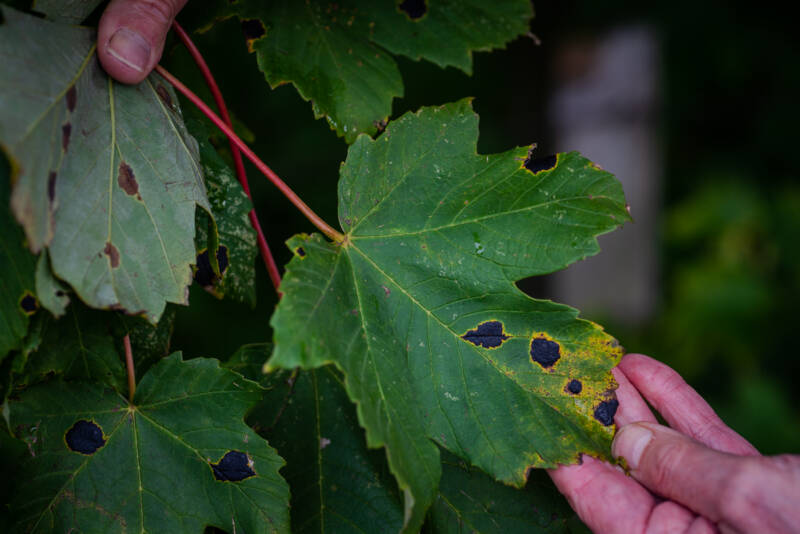
The Sycamore is probably best identified by its Maple shaped leaf (think Canadian flag) and its red stem (or petiole – the stalk that attaches the leaf to the twig or branch). Imported by the Romans, Sycamore is not technically native, but Andrew considers it ‘naturalised’. There are two other trees in the Maple family that are native to the UK, but they are smaller than this one. It’s happiest near water, in rich, brown soils and is another tough species. Felicity points out they are often planted near farmhouses to provide shelter, and they thrive well on exposed coasts, seemingly impervious to salt laden winds. It is quite close to Ash in terms of its ecological niche and could replace it, should Dieback disease cause that population to collapse completely, which sadly seems likely.
Holly

A tree even I can recognise, Holly is an evergreen broadleaf with very dense timber that grows very slowly. It’s dioecious, which means that the male and female flowers (berries) occur on different individual trees – these species need 2 parents, but most don’t. Monoecious tree species have male and female flowers together on the same tree and then employ all manner of strategies to avoid self-pollination.
Historically holly was valued as the best material for making riding crops. Side branches were trained and pruned of their lateral shoots and fashioned into crops and whips. It was also used in wood turning and as protective hedging, as well as for the seasonal decoration we’re more familiar with.
Scots Pine
The only pine tree native to Scotland, and easily distinguished from other pine species by their twin-needles contained in a basal leaf sheath, which detach themselves as a ‘wishbone’. On a more mature tree, the upper branches also turn a salmon pink colour, which other species of pine don’t.
Scots pine is a good example of a monecious species. The pinecones (the female fruits) are generally in the top part of the canopy and the male flowers at the bottom, as a way of minimising self-fertilising. This way, the wind will tend to move the pollen from one tree away from its own cones.
Globally, there are two, three and five needle pines. The Scots pine isn’t just found in Scotland, it occurs from Norway through to Kamchatka. Scots pine was and is an important building timber and is also used to produce turpentine, historically used in lamps or as a solvent.
Birch
The silver birch (left) is identified by its silvery bark, and a more diamond shaped leaf, with a straight edge into the petiole, along the back of the leaf. The rest of the leaf is sharply serrated and quite pointed. As the tree matures, the silver trunk will have black fissures, sometimes referred to as ‘eyes’ in mythology.
The downy birch leaf (right) has a curved back into the petiole, and the serrations are carried all the way around to the back as well, quite unlike the silver birch leaf. The trunk is distinguished by bands rather than ‘eyes’. The individual leaves on both trees are quite small.
Birch is a ‘pioneer species’ which does well in poorer soils where other trees don’t flourish. It’s a good source of firewood and two of the mushrooms that grow from its trunk (known as bracket fungus) provided traditional peoples with wound dressings and a way of carrying embers from camp to camp.
Lime
Distinguished by a leathery, broad heart shaped leaf, this one is probably a large leaf lime. Lime isn’t native to Scotland, although here as elsewhere, they were often planted for decorative purposes, in parkland or along avenues. The blossom is used in tea, while the bark was sometimes used in medicine. The fibrous ‘underbark’ was also traditionally stripped out and twisted for use in ropemaking. The distinctive ‘drumstick’ fruit are another useful way of identifying them.
Rowan

Rowan is sometimes also known as mountain ash, despite not being related to Ash – perhaps because its leaves are similar. Instead, it’s a part of the Rose family. It was traditionally planted near homes and churches to ward off evil spirits, and as such it was considered bad luck to cut one down. The berries are very tart but can be made into a jelly. Andrew reckons they work best after they’ve seen the first frosts, and in the mix with Crab apples, whose pectin provides a thicker, less runny condiment that goes down well with venison.
To my untrained eye, at first glance the bark can look quite like birch, but the leaves and berries tell it apart from that other tree.
Hawthorn
Common Hawthorn is a woody shrub or small tree that traditionally would have been used in hedging to keep livestock contained. Creating a dense hedge would mean half cutting through the base of the bush and laying it down, which thickens the bottom of the hedge and encourages new vertical growth. It’s another pioneer species, and is often first on the scene if grazing is eased or removed on grassland. It provides home and food to a huge array of insects, as well as wood mice and birds like the yellowhammer.
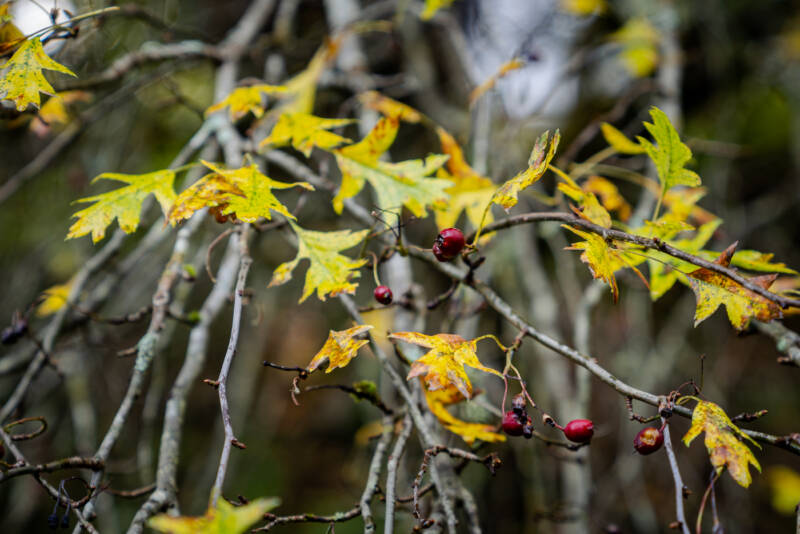
The phrase ‘cast ne’er a clout till may is out’ refers to the plentiful white blossom produced by the Hawthorn in the spring, rather than the month itself. In the autumn, the shiny, lobed (between 3 and 7 – this image shows 5) leaves move through vibrant oranges and reds and the bush produces compact red berries.
Hazel
Producer of hazel or ‘cob’ nuts and walking sticks, the Hazel coppices well and when cultivated as a crop on a short rotation (5-10 years), the trunks are thin, straight and tall. The leaves are quite round, serrated with an almost ‘webbed foot’ edge leading to a defined, elegant point.
Aspen
The Aspen most often turns a vibrant yellow gold colour in late autumn, but then so does birch, so how can you tell the difference? One of the ways is the trunk – where the silver birch will have dark oval or round fissures, Aspen’s are diamond shaped. These are actually ‘lenticels’ – a breathable pore that allows water and gases to enter and leave the tree.
Aspen is the only native poplar in Scotland, and notable for its shimmering leaves in the wind, another tell-tale sign from a distance. One side of the leaf is lighter than the other, and the petiole is slightly flattened, which means that all the leaves oscillate rapidly in a breeze, producing a distinctive rustling sound.
Surprisingly, aspen can lay claim to being the largest tree in Britain because of how it spreads underground and throws up new clonal shoots. This means that a whole stand of Aspen can come from one parent tree. It’s at the edge of its climatic range in Scotland, and another dioecious species, with male and female flowers on separate trees. Unless there is a stand of the opposite sex close by, it seldom produces seed in Scotland. It’s also very tasty to sheep and deer, partly because it produces prolific suckers at browsing height. Centuries of overgrazing have contributed to its rarity.
The wood was traditionally used as cobble tiles in courtyards. A very soft timber, it would dull the noise of a horse and carriage as they rolled into the palaces of the rich, so as not to wake the gentry!
Goat Willow
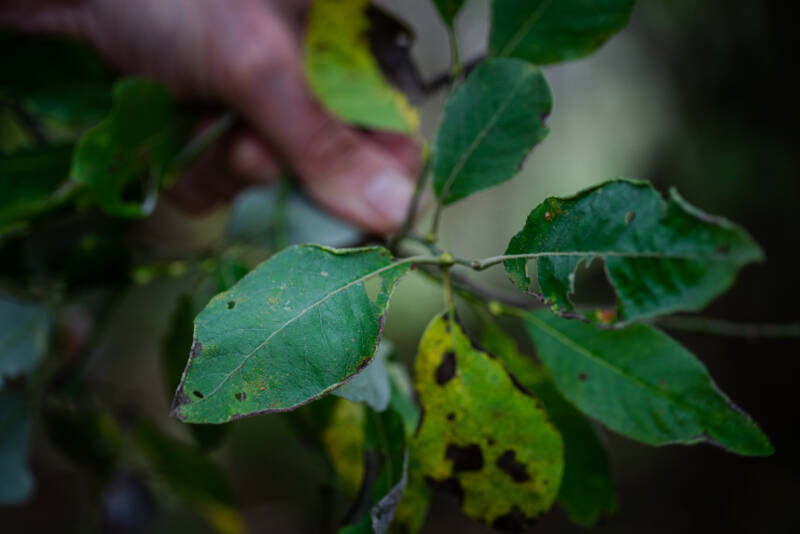
Sometimes also known as pussy willow, its leaves vary a little but are generally more oval with a pointed end that leans to one side. They are hairy underneath but not on top. Those leaves are the main food of many moth caterpillars, and its catkins provide lots of nectar for bees and other insects, which in turn attracts the birds. Goat willow is another dioecious species, but it can also ‘layer’ lower branches that are in contact with the ground, grow new roots and propagate itself that way. Trees are weird!
Willow is well known for producing salicylic acid, the key ingredient in aspirin. In the past, people chewed the bark or boiled it in water to relieve toothache, diarrhoea, and deal with inflammation. It’s a tough and resilient tree that grows easily, coppices well and so was also used extensively for firewood, charcoal and as ‘wattle’ – the internal framework in old fashioned internal walls.
Sessile Oak
The Sessile Oak is native to Scotland. Oak leaves in general have quite a distinctive wavy shape, but the Sessile can be distinguished from other species of oak by its acorns, which are directly attached to the twigs, and leaves which are attached by a short stem. For the English oak, that’s reversed: it has acorns suspended on a stem or ‘peduncle’ (giving it it’s formal name – Pedunculate Oak), but the leaves come straight off the twig.
Oak supports up to 500 other lifeforms – birds, insects, fungi, ferns, mosses, and lichens – and so it’s no surprise there’s a renewed focus on it. On the west coast in particular, it was the basis of a vast industry in the past, the bark stripped for tanning leather and the timber used to produce charcoal for iron smelting. Like Scots Pine, Oak stocks were also heavily impacted due to ship building during colonial expansion. Old stands of Atlantic (sessile) oak woodland are now quite rare, but good examples can be seen at Taynish in Argyll and Ariundle on Loch Sunart.
The photo on the right shows another variety of Gall Wasp – the silk button. Unlike the Alder variety, these tiny galls containing wasp larvae are borne on the underside of the leaf rather than the top and fall to the forest floor before the leaf does.














